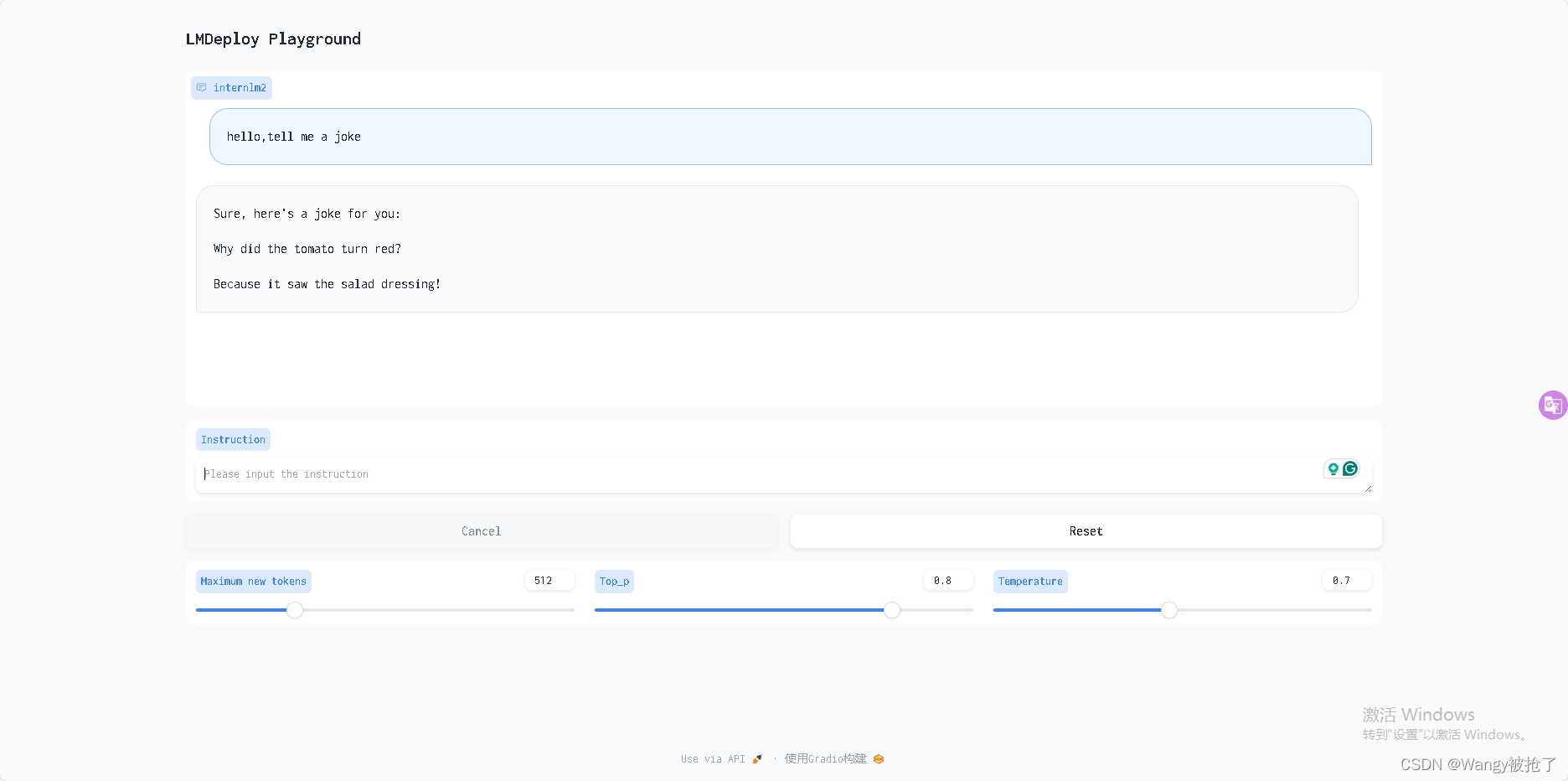视频链接:LMDeploy 量化部署 LLM-VLM 实践_哔哩哔哩_bilibili
项目链接:https://github.com/InternLM/Tutorial/blob/camp2/lmdeploy/README.md
5.0 LMDeploy介绍
5.0.1 模型部署面临的挑战
计算密集(compute-bound): 指推理过程中,绝大部分时间消耗在数值计算上;针对计算密集型场景,可以通过使用更快的硬件计算单元来提升计算速度。
访存密集(memory-bound): 指推理过程中,绝大部分时间消耗在数据读取上;针对访存密集型场景,一般通过减少访存次数、提高计算访存比或降低访存量来优化。
常见的 LLM 模型由于 Decoder Only 架构的特性,实际推理时大多数的时间都消耗在了逐 Token 生成阶段(Decoding 阶段),是典型的访存密集型场景。
(1)大模型前向推理计算量大,部署困难。
20B的小模型计算一个token需要进行406亿次浮点数计算,175B的大模型计算千万亿次。对比A100显卡性能,每秒77万亿。
前向推理计算量 = 2*参数量 + 2*模型层数*记忆长度*注意力输出的维度,浮点数运算数量
 (2)内存开销大
(2)内存开销大
加载:20B模型加载占40G+显存,175B模型需要350G+显存。
推理:参数KV,FP16 + BATCH_SIZE=16 + INPUT_TOKENS=512 + OUTPUT_TOKENS=32 ——>10G+缓存。
A100 最大80G显存

(3)访存瓶颈
BATCH_SIZE=1 + INPUT_TOKENS=1000 + OUTPUT_TOKENS=250 = 计算量是6.83万亿次
6.83TFLOPs+中间结果+写入 = 访存32.62T。
4090的FP16计算性能是每秒82.58万亿次,6.83/82.58<<10%。但显存带宽1008G/S每秒一万亿个字节数,6.83万亿/1万亿=6秒,大部分时间是浪费到传输数据。

5.0.2 模型部署方法
(1)模型剪枝
用不到的参数剪掉

(2)知识蒸馏
不是所有参数有用,间接训练一个没有冗余参数的小模型:先训练一个大模型(“教师”模型),通过模型迁移获得小模型(“学生”模型)

(3)量化
改变表示格式:浮点数转换成整数或其他离散格式。模型参数默认是存储成32位浮点数,占4个字节。减小存储位数可以尽可能多的传输数据,即使还要反量化,这也只是增加了计算量,却没有达到访存瓶颈。

5.0.3 LMDeploy
轻量化部署工具,高效推理引擎TurboMind、W4A16量化(AWQ,FP16->INT4,压缩到1/4)、服务化部署


5.1 搭建环境
开发机和conda环境创建:10%A100,镜像Cuda12.2-conda
激活环境和安装包LMDeploy
studio-conda -t lmdeploy -o pytorch-2.1.2
conda activate lmdeploy
pip install lmdeploy[all]==0.3.05.2 与模型对话:Transformer库 v.s. LMDeploy
Transformer库直接运行HF格式模型,LMDeploy要将HF格式模型转换为TurboMind格式的模型。
5.2.1 Transformer库
创建软链接,下载文件夹/root/share/new_models/Shanghai_AI_Laboratory/internlm2-chat-1_8b的模型
与模型对话,创建对话文件pipeline_transformer.py。对话文件代码见项目链接2.3节。
# 创建软链接
ln -s /root/share/new_models/Shanghai_AI_Laboratory/internlm2-chat-1_8b /root/
#创建对话文件pipeline_transformer.py
touch /root/pipeline_transformer.py
# 运行
python /root/pipeline_transformer.py实验结果:大概八分钟完成实验

5.2.2 LMDeploy
LMDeploy与模型进行对话的指令:
# 指令格式lmdeploy chat [HF格式模型路径/TurboMind格式模型路径]
lmdeploy chat /root/internlm2-chat-1_8b实验结果:大概两分钟完成实验

5.3 LMDeploy模型量化(lite)
量化是一种以参数或计算中间结果精度下降换空间节省(以及同时带来的性能提升)的策略。
KV8量化和W4A16量化:
KV8量化是指将逐 Token(Decoding)生成过程中的上下文 K 和 V 中间结果进行 INT8 量化(计算时再反量化),以降低生成过程中的显存占用。代价是模型推理速度降低。
W4A16 量化,将 FP16 的模型权重量化为 INT4,Kernel 计算时,访存量直接降为 FP16 模型的 1/4,大幅降低了访存成本。Weight Only 是指仅量化权重,数值计算依然采用 FP16(需要将 INT4 权重反量化)。
5.3.1 设置最大KV Cache缓存大小——KV8量化对比实验
KV Cache:
一种缓存技术,通过存储键值对的形式来复用计算结果,以达到提高性能和降低内存消耗的目的。在大规模训练和推理中,KV Cache可以显著减少重复计算量,从而提升模型的推理速度。理想情况下,KV Cache全部存储于显存,以加快访存速度。当显存空间不足时,也可以将KV Cache放在内存,通过缓存管理器控制将当前需要使用的数据放入显存。
模型在运行时,占用的显存可大致分为三部分:模型参数本身占用的显存、KV Cache占用的显存,以及中间运算结果占用的显存。即三部分共分A100的80G。LMDeploy的KV Cache管理器可以通过设置--cache-max-entry-count参数,控制KV缓存占用剩余显存的最大比例。默认的比例为0.8。
下面通过几个例子,来看一下调整--cache-max-entry-count参数的效果。
# 0.8
lmdeploy chat /root/internlm2-chat-1_8b
# 0.5
lmdeploy chat /root/internlm2-chat-1_8b --cache-max-entry-count 0.5
# 0.01
lmdeploy chat /root/internlm2-chat-1_8b --cache-max-entry-count 0.01(1)不加该参数(默认0.8),运行1.8B模型
显存占用7856M/8182M=96.02%。

(2)--cache-max-entry-count 0.5
6608M/8182M=80.76%

(3)--cache-max-entry-count 0.01
模型本身和中间结果占用显存,4560M/8182M=55.63%

5.3.2 使用W4A16量化
命令:
# 安装依赖库
pip install einops==0.7.0
# lite量化 auto_awq自动量化方法 模型 ptb数据集 采样率128
lmdeploy lite auto_awq \
/root/internlm2-chat-1_8b \
--calib-dataset 'ptb' \
--calib-samples 128 \
--calib-seqlen 1024 \
--w-bits 4 \
--w-group-size 128 \
--work-dir /root/internlm2-chat-1_8b-4bit
7432M

0.01:2472M

5.4 LMDeploy服务(serve)
(1)运行命令行客户端
lmdeploy serve api_server \
/root/internlm2-chat-1_8b \
--model-format hf \
--quant-policy 0 \
--server-name 0.0.0.0 \
--server-port 23333 \
--tp 1

(2) 网页客户端连接API服务器
lmdeploy serve gradio http://localhost:23333 \
--server-name 0.0.0.0 \
--server-port 6006
ssh -CNg -L 6006:127.0.0.1:6006 root@ssh.intern-ai.org.cn -p <你的ssh端口号>
访问地址http://127.0.0.1:6006
5.5 Python代码集成
(1)代码集成运行模型
conda activate lmdeploy
touch /root/pipeline.py
# pipeline.py
from lmdeploy import pipeline
pipe = pipeline('/root/internlm2-chat-1_8b')
response = pipe(['Hi, pls intro yourself', '上海是'])
print(response)
# 运行
python /root/pipeline.py
(2)代码集成实现量化
touch /root/pipeline_kv.py
# pipeline_kv.py
from lmdeploy import pipeline, TurbomindEngineConfig
# 调低 k/v cache内存占比调整为总显存的 20%
backend_config = TurbomindEngineConfig(cache_max_entry_count=0.2)
pipe = pipeline('/root/internlm2-chat-1_8b',
backend_config=backend_config)
response = pipe(['Hi, pls intro yourself', '上海是'])
print(response)
5.6 使用LMDeploy运行视觉多模态大模型llava
(1)代码
# 激活环境
conda activate lmdeploy
# 安装包
pip install git+https://github.com/haotian-liu/LLaVA.git@4e2277a060da264c4f21b364c867cc622c945874
# 创建文件
touch /root/pipeline_llava.py
# pipeline_llava.py
from lmdeploy.vl import load_image
from lmdeploy import pipeline, TurbomindEngineConfig
backend_config = TurbomindEngineConfig(session_len=8192) # 图片分辨率较高时请调高session_len
# pipe = pipeline('liuhaotian/llava-v1.6-vicuna-7b', backend_config=backend_config) 非开发机运行此命令
pipe = pipeline('/share/new_models/liuhaotian/llava-v1.6-vicuna-7b', backend_config=backend_config)
image = load_image('https://raw.githubusercontent.com/open-mmlab/mmdeploy/main/tests/data/tiger.jpeg')
response = pipe(('describe this image', image))
print(response)
# 运行
python /root/pipeline_llava.py
(2)网页端

5.7 定量比较LMDeploy与Transformer库的推理速度差异
Transformer库推理Internlm2-chat-1.8b的速度,新建python文件benchmark_transformer.py,填入以下内容,再运行。
import torch
import datetime
from transformers import AutoTokenizer, AutoModelForCausalLM
tokenizer = AutoTokenizer.from_pretrained("/root/internlm2-chat-1_8b", trust_remote_code=True)
# Set `torch_dtype=torch.float16` to load model in float16, otherwise it will be loaded as float32 and cause OOM Error.
model = AutoModelForCausalLM.from_pretrained("/root/internlm2-chat-1_8b", torch_dtype=torch.float16, trust_remote_code=True).cuda()
model = model.eval()
# warmup
inp = "hello"
for i in range(5):
print("Warm up...[{}/5]".format(i+1))
response, history = model.chat(tokenizer, inp, history=[])
# test speed
inp = "请介绍一下你自己。"
times = 10
total_words = 0
start_time = datetime.datetime.now()
for i in range(times):
response, history = model.chat(tokenizer, inp, history=history)
total_words += len(response)
end_time = datetime.datetime.now()
delta_time = end_time - start_time
delta_time = delta_time.seconds + delta_time.microseconds / 1000000.0
speed = total_words / delta_time
print("Speed: {:.3f} words/s".format(speed))测试LMDeploy的推理速度,新建python文件benchmark_lmdeploy.py,填入以下内容,运行。
import datetime
from lmdeploy import pipeline
pipe = pipeline('/root/internlm2-chat-1_8b')
# warmup
inp = "hello"
for i in range(5):
print("Warm up...[{}/5]".format(i+1))
response = pipe([inp])
# test speed
inp = "请介绍一下你自己。"
times = 10
total_words = 0
start_time = datetime.datetime.now()
for i in range(times):
response = pipe([inp])
total_words += len(response[0].text)
end_time = datetime.datetime.now()
delta_time = end_time - start_time
delta_time = delta_time.seconds + delta_time.microseconds / 1000000.0
speed = total_words / delta_time
print("Speed: {:.3f} words/s".format(speed))实验结果如下:Transformer库的推理速度约为78.675 words/s,注意单位是words/s,不是token/s,word和token在数量上可以近似认为成线性关系。LMDeploy的推理速度约为473.690 words/s,是Transformer库的6倍。
























 409
409

 被折叠的 条评论
为什么被折叠?
被折叠的 条评论
为什么被折叠?








